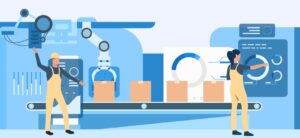Running a small business is like being the captain of a ship where every resource matters. You have limited crew members, tight budgets, and the pressure to make the right call quickly. But when your data is scattered across spreadsheets, disconnected apps, and multiple teams, steering your business toward growth becomes guesswork. This is where centralized data can be your operational game-changer.
In this blog, we will explore how small businesses can streamline operations with centralized data, why it is no longer a “big company” privilege, and how you can take practical steps to implement it in your organization today.
Why Small Businesses Struggle Without Centralized Data
Imagine this: Your sales team tracks leads in a Google Sheet, your inventory is managed in a separate app, your marketing reports are in another dashboard, and your accounting software sits in its own silo. None of these systems talk to each other. This fragmentation creates:
- Duplicate work: Teams manually re-enter the same data in different systems. (For instance, a small café owner spends an extra 3-4 hours every week typing supplier invoices into both their accounting software and inventory tracker.)
- Inconsistent information: Customer details differ across departments, leading to embarrassing mistakes. (A cleaning service once double-booked a slot because the CRM didn’t sync with their scheduling tool.)
- Slow decision-making: By the time you gather and reconcile the data, the opportunity has passed. (A local gift shop missed running a flash sale because sales trends were identified only after the holiday weekend ended.)
- Poor customer experience: Your support team does not have the complete customer history at hand. (A repeat customer at a small electronics store had to explain a past repair issue three times because support couldn’t access the sales team’s records.)
What Centralized Data Really Means for Small Businesses
Centralized data means bringing all your business information sales, marketing, operations, finance, inventory, and customer data into a single, unified platform. This could be achieved through a centralized database, an integrated CRM, or a cloud-based data platform that connects to all your existing tools.
When implemented correctly, centralized data offers small businesses:
- One source of truth: Everyone in the company works with the same updated information.
- Streamlined workflows: No more jumping between systems to complete a single task.
- Better insights: Real-time analytics on your customers, sales, and operations.
- Time savings: Automation eliminates repetitive data entry and manual updates.
How Centralized Data Streamlines Operations
Let’s break down how this approach can transform your day-to-day operations.
Faster Decision-Making
When data from all departments is connected, you can see the big picture instantly. For example, if sales are slowing, you can immediately check whether the cause is reduced marketing engagement, delayed inventory shipments, or a seasonal pattern.
Example: When data from all departments is connected, you can see the big picture instantly. For example, if sales are slowing, you can immediately check whether the cause is reduced marketing engagement, delayed inventory shipments, or a seasonal pattern.
Improved Customer Experience
Customers hate repeating themselves. Centralized data ensures that when a customer calls, your team can see their complete history purchases, complaints, preferences without digging through multiple systems. This level of personalization builds trust and loyalty.
Example: A small flower delivery service linked its CRM with its ordering app. Now, when a customer calls for Mother’s Day flowers, staff can quickly see last year’s order, delivery address, and even the note they sent, allowing them to offer, “Would you like us to send the same bouquet as last year?” That small touch boosted repeat orders by 22%.
More Accurate Forecasting
Whether you are predicting inventory needs, planning budgets, or projecting sales, centralized data gives you reliable, consistent figures. Small businesses can plan with confidence rather than relying on “gut feeling” estimates.
Example: A neighborhood bakery uses centralized sales and supplier data to see that croissant sales jump 30% on Saturdays. They now adjust supplier orders every Thursday instead of guessing, reducing waste by 15% and avoiding stockouts on weekends.
Reduced Redundancy and Errors
When your systems talk to each other, you eliminate double entry. No more entering the same invoice into accounting and then again into a sales tracker. This saves time and reduces human errors.
Example: A home décor retailer integrated their POS, e-commerce, and accounting software. Before integration, one incorrect invoice took 45 minutes to fix across three systems. Now, updates happen in real time, and the issue is resolved in under 5 minutes.
Cost Efficiency
Manually managing fragmented data wastes hours of labor each week. Over time, that is money lost. By centralizing, you can cut down on operational overhead and focus resources on growth.
Example: A small marketing agency realized their project managers were spending an average of 6 hours a week compiling client reports from different tools. By centralizing data into a single dashboard, they reduced that time to 1 hour — saving 20+ hours a month that could be billed to clients instead.
Choosing the Right Centralized Data Solution for Your Business
Small businesses do not need to spend enterprise-level budgets to enjoy the benefits of centralized data. The right approach depends on your business size, industry, and current tech stack. Partnering with an experienced provider like Intellectyx can help you assess your needs, select the right tools, and ensure smooth implementation without disrupting daily operations.
Step 1: Map Your Current Data Sources
List all tools where your data lives. CRMs, spreadsheets, accounting software, inventory apps, marketing platforms, and more. Intellectyx can work with your team to identify every data source, even the ones you may have overlooked, so nothing falls through the cracks.
Step 2: Identify Integration Gaps
Look for tools that offer native integrations or use middleware to connect the ones that do not. The goal is to reduce manual exports and imports. With Intellectyx, you get expert guidance on selecting integration options that match your budget, timeline, and operational goals.
Step 3: Choose a Scalable Platform
Your needs will grow. Pick a solution that allows you to add more users, connect more apps, and expand storage without replatforming. Intellectyx specializes in designing scalable, cloud-based centralized data systems that grow with your business while keeping costs predictable.
Step 4: Prioritize Security and Compliance
Centralized data should still be secure. Ensure your platform has encryption, role-based access, and compliance with relevant regulations like GDPR. Intellectyx implements industry-best security practices so your business data remains protected at all times.
How to Overcome Common Concerns
Some small business owners hesitate to centralize their data because they fear high costs, complicated setup, or losing control. The truth is:
- Cost: Cloud-based solutions often work on affordable monthly subscriptions.
- Complexity: Many modern platforms are designed for non-technical users.
- Control: Centralization actually gives you more control, as you can set user permissions and track changes.
Getting Started: Your First 30 Days
Here is a practical roadmap you can follow:
- Week 1: Audit all current data sources and map integration points.
- Week 2: Choose a centralized platform and set up core integrations (CRM, accounting, inventory).
- Week 3: Migrate historical data and test workflows for accuracy.
- Week 4: Train your team and launch company-wide usage.
By the end of 30 days, you will notice immediate efficiency gains.
Why Centralized Data is a Competitive Advantage for Small Businesses
Big companies have long used data warehouses and integrated analytics to stay ahead. The difference now is that technology has leveled the playing field. Affordable cloud-based platforms mean small businesses can access the same power without needing a dedicated IT team.
The businesses that act now will gain:
- Speed: Make decisions faster than competitors.
- Accuracy: Base strategies on real data, not assumptions.
- Customer loyalty: Offer seamless, personalized experiences.
Those who delay risk being outpaced by competitors who can respond to market changes in real time.
Final Thoughts
Centralized data is not just about technology. It is about giving your small business the clarity, speed, and agility to compete in a fast-changing market. By unifying your systems and workflows, you free your team from repetitive manual work and empower them to focus on what truly matters: serving customers and growing the business. If you are ready to unlock the full potential of your small business, start by auditing your current data systems today. The sooner you connect your tools and centralize your information, the sooner you will see measurable results in efficiency, customer satisfaction, and profitability.
Take the first step now. Streamline your operations, centralize your data, and watch your business performance accelerate. Schedule a free consultation with our data experts to map out your centralization strategy today.




